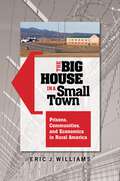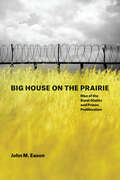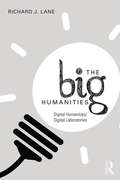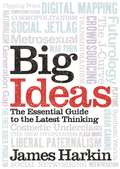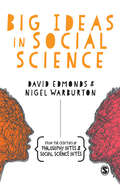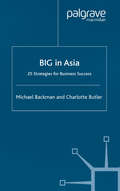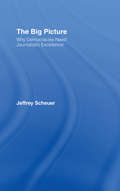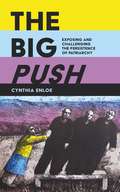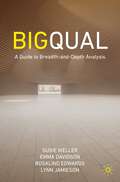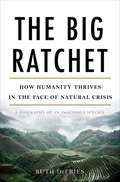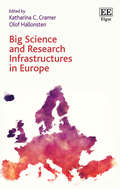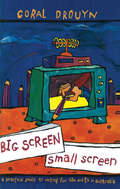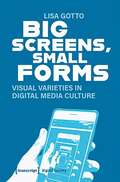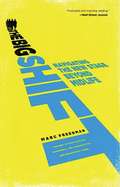- Table View
- List View
The Big House in a Small Town: Prisons, Communities, and Economics in Rural America
by Eric J. WilliamsThis work is an in-depth, on-the-ground examination of how prisons impact rural communities, including a revealing study of two rural communities that have chosen prisons as an economic development strategy.A recent study by the Urban Institute estimates that one-third of all counties in the United States house a prison, and that our prison and jail population is now over 2.1 million. Another report indicates that more than 97 percent of all U.S. prisoners are eventually released, and communities are absorbing nearly 650,000 formerly incarcerated individuals each year. These figures are particularly alarming considering the fact that rural communities are using prisons as economic development vehicles without fully understanding the effects of these jails on the area.This book is the result of author Eric J. Williams' ground-level research about the effects of prisons upon two rural American communities that lobbied to host maximum security prisons. Through hundreds of interviews conducted while living in Florence, Colorado, and Beeville, Texas, Williams offers the perspective of local residents on all sides of the issue, as well as a social history told mainly from the standpoint of those who lobbied for the prisons.
Big House on the Prairie: Rise of the Rural Ghetto and Prison Proliferation
by John M. EasonFor the past fifty years, America has been extraordinarily busy building prisons. Since 1970 we have tripled the total number of facilities, adding more than 1,200 new prisons to the landscape. This building boom has taken place across the country but is largely concentrated in rural southern towns. In 2007, John M. Eason moved his family to Forrest City, Arkansas, in search of answers to key questions about this trend: Why is America building so many prisons? Why now? And why in rural areas? Eason quickly learned that rural demand for prisons is complicated. Towns like Forrest City choose to build prisons not simply in hopes of landing jobs or economic wellbeing, but also to protect and improve their reputations. For some rural leaders, fostering a prison in their town is a means of achieving order in a rapidly changing world. Taking us into the decision-making meetings and tracking the impact of prisons on economic development, poverty, and race, Eason demonstrates how groups of elite whites and black leaders share power. Situating prisons within dynamic shifts that rural economies are undergoing and showing how racially diverse communities lobby for prison construction, Big House on the Prairie is a remarkable glimpse into the ways a prison economy takes shape and operates.
Big House on the Prairie: Rise of the Rural Ghetto and Prison Proliferation
by John M. EasonFor the past fifty years, America has been extraordinarily busy building prisons. Since 1970 we have tripled the total number of facilities, adding more than 1,200 new prisons to the landscape. This building boom has taken place across the country but is largely concentrated in rural southern towns. In 2007, John M. Eason moved his family to Forrest City, Arkansas, in search of answers to key questions about this trend: Why is America building so many prisons? Why now? And why in rural areas? Eason quickly learned that rural demand for prisons is complicated. Towns like Forrest City choose to build prisons not simply in hopes of landing jobs or economic wellbeing, but also to protect and improve their reputations. For some rural leaders, fostering a prison in their town is a means of achieving order in a rapidly changing world. Taking us into the decision-making meetings and tracking the impact of prisons on economic development, poverty, and race, Eason demonstrates how groups of elite whites and black leaders share power. Situating prisons within dynamic shifts that rural economies are undergoing and showing how racially diverse communities lobby for prison construction, Big House on the Prairie is a remarkable glimpse into the ways a prison economy takes shape and operates.
Big House on the Prairie: Rise of the Rural Ghetto and Prison Proliferation
by John M. EasonFor the past fifty years, America has been extraordinarily busy building prisons. Since 1970 we have tripled the total number of facilities, adding more than 1,200 new prisons to the landscape. This building boom has taken place across the country but is largely concentrated in rural southern towns. In 2007, John M. Eason moved his family to Forrest City, Arkansas, in search of answers to key questions about this trend: Why is America building so many prisons? Why now? And why in rural areas? Eason quickly learned that rural demand for prisons is complicated. Towns like Forrest City choose to build prisons not simply in hopes of landing jobs or economic wellbeing, but also to protect and improve their reputations. For some rural leaders, fostering a prison in their town is a means of achieving order in a rapidly changing world. Taking us into the decision-making meetings and tracking the impact of prisons on economic development, poverty, and race, Eason demonstrates how groups of elite whites and black leaders share power. Situating prisons within dynamic shifts that rural economies are undergoing and showing how racially diverse communities lobby for prison construction, Big House on the Prairie is a remarkable glimpse into the ways a prison economy takes shape and operates.
Big House on the Prairie: Rise of the Rural Ghetto and Prison Proliferation
by John M. EasonFor the past fifty years, America has been extraordinarily busy building prisons. Since 1970 we have tripled the total number of facilities, adding more than 1,200 new prisons to the landscape. This building boom has taken place across the country but is largely concentrated in rural southern towns. In 2007, John M. Eason moved his family to Forrest City, Arkansas, in search of answers to key questions about this trend: Why is America building so many prisons? Why now? And why in rural areas? Eason quickly learned that rural demand for prisons is complicated. Towns like Forrest City choose to build prisons not simply in hopes of landing jobs or economic wellbeing, but also to protect and improve their reputations. For some rural leaders, fostering a prison in their town is a means of achieving order in a rapidly changing world. Taking us into the decision-making meetings and tracking the impact of prisons on economic development, poverty, and race, Eason demonstrates how groups of elite whites and black leaders share power. Situating prisons within dynamic shifts that rural economies are undergoing and showing how racially diverse communities lobby for prison construction, Big House on the Prairie is a remarkable glimpse into the ways a prison economy takes shape and operates.
Big House on the Prairie: Rise of the Rural Ghetto and Prison Proliferation
by John M. EasonFor the past fifty years, America has been extraordinarily busy building prisons. Since 1970 we have tripled the total number of facilities, adding more than 1,200 new prisons to the landscape. This building boom has taken place across the country but is largely concentrated in rural southern towns. In 2007, John M. Eason moved his family to Forrest City, Arkansas, in search of answers to key questions about this trend: Why is America building so many prisons? Why now? And why in rural areas? Eason quickly learned that rural demand for prisons is complicated. Towns like Forrest City choose to build prisons not simply in hopes of landing jobs or economic wellbeing, but also to protect and improve their reputations. For some rural leaders, fostering a prison in their town is a means of achieving order in a rapidly changing world. Taking us into the decision-making meetings and tracking the impact of prisons on economic development, poverty, and race, Eason demonstrates how groups of elite whites and black leaders share power. Situating prisons within dynamic shifts that rural economies are undergoing and showing how racially diverse communities lobby for prison construction, Big House on the Prairie is a remarkable glimpse into the ways a prison economy takes shape and operates.
Big House on the Prairie: Rise of the Rural Ghetto and Prison Proliferation
by John M. EasonFor the past fifty years, America has been extraordinarily busy building prisons. Since 1970 we have tripled the total number of facilities, adding more than 1,200 new prisons to the landscape. This building boom has taken place across the country but is largely concentrated in rural southern towns. In 2007, John M. Eason moved his family to Forrest City, Arkansas, in search of answers to key questions about this trend: Why is America building so many prisons? Why now? And why in rural areas? Eason quickly learned that rural demand for prisons is complicated. Towns like Forrest City choose to build prisons not simply in hopes of landing jobs or economic wellbeing, but also to protect and improve their reputations. For some rural leaders, fostering a prison in their town is a means of achieving order in a rapidly changing world. Taking us into the decision-making meetings and tracking the impact of prisons on economic development, poverty, and race, Eason demonstrates how groups of elite whites and black leaders share power. Situating prisons within dynamic shifts that rural economies are undergoing and showing how racially diverse communities lobby for prison construction, Big House on the Prairie is a remarkable glimpse into the ways a prison economy takes shape and operates.
The Big Humanities: Digital Humanities/Digital Laboratories
by Richard J. LaneThis book provides an accessible introduction to, and overview of, the digital humanities, one of the fastest growing areas of literary studies. Lane takes a unique approach by focusing on the technologies and the new environment in which the digital humanities largely takes place: the digital laboratory. The book provides a brief history of DH, explores and explains the methodologies of past and current DH projects, and offers resources such as detailed case studies and bibliographies. Further, the focus on the digital laboratory space reveals affiliations with the types of research that have traditionally taken place in the sciences, as well as convergences with other fast-growing research spaces, namely innovation labs, fabrication labs, maker spaces, digital media labs, and change labs. The volume highlights the profound transformation of literary studies that is underway, one in which the adoption of powerful technology – and concomitantly being situated within a laboratory environment – is leading to an important re-engagement in the arts and humanities, and a renewed understanding of literary studies in the digital age, as well as a return to large-scale financial investment in humanistic research. It will be useful to students and teachers, as well as administrators and managers in charge of research infrastructure and funding decisions who need an accessible overview of this technological transformation in the humanities. Combining useful detail and an overview of the field, the book will offers accessible entry into this rapidly growing field.
The Big Humanities: Digital Humanities/Digital Laboratories
by Richard J. LaneThis book provides an accessible introduction to, and overview of, the digital humanities, one of the fastest growing areas of literary studies. Lane takes a unique approach by focusing on the technologies and the new environment in which the digital humanities largely takes place: the digital laboratory. The book provides a brief history of DH, explores and explains the methodologies of past and current DH projects, and offers resources such as detailed case studies and bibliographies. Further, the focus on the digital laboratory space reveals affiliations with the types of research that have traditionally taken place in the sciences, as well as convergences with other fast-growing research spaces, namely innovation labs, fabrication labs, maker spaces, digital media labs, and change labs. The volume highlights the profound transformation of literary studies that is underway, one in which the adoption of powerful technology – and concomitantly being situated within a laboratory environment – is leading to an important re-engagement in the arts and humanities, and a renewed understanding of literary studies in the digital age, as well as a return to large-scale financial investment in humanistic research. It will be useful to students and teachers, as well as administrators and managers in charge of research infrastructure and funding decisions who need an accessible overview of this technological transformation in the humanities. Combining useful detail and an overview of the field, the book will offers accessible entry into this rapidly growing field.
Big Ideas: The Essential Guide to the Latest Thinking
by James HarkinA witty and indispensable guide to modern-day buzzwords.Big Ideas explains where concepts like 'the long tail', 'urban tribes' and 'soft power' came from, what they mean, and what their critics say about them. It includes explanations of key terms such as: Maturialism: the name given to the new trend among middle-aged people of spending their money on expensive 'youth' gadgets and services, and the new habit among advertisers of targeting the mid-life market, repositioning their brands as accessories to the distinctive joys of mid-life. The Tipping Point: the controversial idea that the best way to understand everything from changing fashions to the rise of teenage smoking is to imagine people as viruses and social phenomena as contagious epidemics. Social Jet Lag: an ailment suffered by up to half the population, social jet lag is said to arise when our body clocks falls out of synch with the demands of our environments, thus putting us at risk of chronic fatigue and an increased susceptibility to disease.
Big Ideas in Social Science
by David Edmonds Nigel WarburtonAre human beings less violent than before? Why do we adopt certain moral and political judgements? Why is the gap between rich and poor getting bigger? How do we decide which criminal policies are effective? What is the Population Challenge for the 21st Century? What is social science? In Big Ideas in Social Science, David Edmonds and Nigel Warburton put these and more of our society’s burning questions to 18 of the world’s leading social scientists including Steven Pinker, Ann Oakley, Lawrence Sherman, Kate Pickett, Robert J. Shiller and Doreen Massey. The result is a collection of thought-provoking discussions that span the fields of sociology, politics, economics, criminology, geography and many more.From the people who brought us the Philosophy Bites series, Big Ideas in Social Science is a fascinating and accessible introduction to the key ideas and findings of the social sciences. The interviews for this book are based on a series of podcasts, Social Science Bites, sponsored by SAGE. Social Science Bites was inspired by the popular Philosophy Bites podcast (www.philosophybites.com), which was founded by David and Nigel in 2007 and has so far had 26 million downloads. Philosophy Bites has spawned three books, Philosophy Bites, Philosophy Bites Back and Philosophy Bites Again.
Big Ideas in Social Science (PDF)
by David Edmonds Nigel WarburtonAre human beings less violent than before? Why do we adopt certain moral and political judgements? Why is the gap between rich and poor getting bigger? How do we decide which criminal policies are effective? What is the Population Challenge for the 21st Century? What is social science? In Big Ideas in Social Science, David Edmonds and Nigel Warburton put these and more of our society’s burning questions to 18 of the world’s leading social scientists including Steven Pinker, Ann Oakley, Lawrence Sherman, Kate Pickett, Robert J. Shiller and Doreen Massey. The result is a collection of thought-provoking discussions that span the fields of sociology, politics, economics, criminology, geography and many more.From the people who brought us the Philosophy Bites series, Big Ideas in Social Science is a fascinating and accessible introduction to the key ideas and findings of the social sciences. The interviews for this book are based on a series of podcasts, Social Science Bites, sponsored by SAGE. Social Science Bites was inspired by the popular Philosophy Bites podcast (www.philosophybites.com), which was founded by David and Nigel in 2007 and has so far had 26 million downloads. Philosophy Bites has spawned three books, Philosophy Bites, Philosophy Bites Back and Philosophy Bites Again.
Big in Asia: 25 Strategies for Business Success
by M. Backman C. ButlerCompanies operating in post-crisis Asia find themselves confronted by obstacles that hinder development and progress. Written by two leading analysts, this book identifies the transformation of the competitive landscape in Asia. By focusing on the main difficulties faced by companies it provides a series of strategies for business success and show how to avoid failure in Asia. This is an essential guide for companies who wish to make it big in Asia.
The Big Picture: Why Democracies Need Journalistic Excellence
by Jeffrey ScheuerFreedom of the press is the cornerstone of democracy. But, as countless recent examples of lapsed standards in the press since the Jayson Blair affair have shown, the First Amendment is no guarantee that American journalism will be first-rate. A press in crisis is a democracy endangered, argues Jeffrey Scheuer--cultural critic and author of The Sound Bite Society. In his new book, The Big Picture, Scheuer argues that in order for a democracy to thrive it is not enough for its press simply to be free--the press must be exceptional. This book explores journalistic excellence and its essential relationship with democracy, explaining why democracies depend on it and are only as good as their journalism. In The Big Picture, Scheuer explores journalistic excellence from three broad perspectives. First, from the democratic perspective, he shows how journalism is a core democratic function, and journalistic excellence a core democratic value. Then, from an intellectual perspective, he explores the ways in which journalism addresses basic concepts of truth, knowledge, objectivity, and ideology. Finally, from an institutional perspective, he considers the role and possible future of journalism education, the importance of journalistic independence, and the potential for nonprofit journalism to meet the journalistic needs of a democratic society. In lucid and accessible prose, The Big Picture provocatively demonstrates why we must all be vigilant about the quality of journalism today.
The Big Picture: Why Democracies Need Journalistic Excellence
by Jeffrey ScheuerFreedom of the press is the cornerstone of democracy. But, as countless recent examples of lapsed standards in the press since the Jayson Blair affair have shown, the First Amendment is no guarantee that American journalism will be first-rate. A press in crisis is a democracy endangered, argues Jeffrey Scheuer--cultural critic and author of The Sound Bite Society. In his new book, The Big Picture, Scheuer argues that in order for a democracy to thrive it is not enough for its press simply to be free--the press must be exceptional. This book explores journalistic excellence and its essential relationship with democracy, explaining why democracies depend on it and are only as good as their journalism. In The Big Picture, Scheuer explores journalistic excellence from three broad perspectives. First, from the democratic perspective, he shows how journalism is a core democratic function, and journalistic excellence a core democratic value. Then, from an intellectual perspective, he explores the ways in which journalism addresses basic concepts of truth, knowledge, objectivity, and ideology. Finally, from an institutional perspective, he considers the role and possible future of journalism education, the importance of journalistic independence, and the potential for nonprofit journalism to meet the journalistic needs of a democratic society. In lucid and accessible prose, The Big Picture provocatively demonstrates why we must all be vigilant about the quality of journalism today.
The Big Push: Exposing and Challenging the Persistence of Patriarchy
by Cynthia EnloeThis is a manual for taking us to the finishing line of gender equality. Without understanding the incredible tentacles of patriarchy and its reinventions, we are destined to fight old battles as well as new ones. A jolt of new energy for longstanding feminists and a "must read" for our new generations.' — Helena Kennedy, QC Decades of feminist campaigning have resulted in real advances, and yet patriarchy relentlessly continues to thrive. Cynthia Enloe pulls back the curtain on patriarchy to reveal not only the blatant sexism we can all identify, but also the insidious persistence of particular forms of masculinity and authoritarianism in daily life. These diverse and illuminating essays — which take as their starting point experiences from her own life and those of women from around the world — explore the resilience of patriarchal beliefs and values, and identify the unwitting nature of our complicity. She shows how, simply by noticing, questioning and crafting fresh feminist concepts, we can update our resistance and challenge patriarchy’s self-perpetuating core.
Big Qual: A Guide to Breadth-and-Depth Analysis
by Susie Weller Emma Davidson Rosalind Edwards Lynn JamiesonThis upper-level textbook presents a new approach to large scale qualitative analysis – the pioneering breadth-and-depth method. It covers the strengths and deployment of “big qual” as a distinct research methodology. The book will appeal to students and researchers across disciplines and methodological backgrounds.The growing availability of large qualitative data sets presents exciting opportunities. Pooling multiple qualitative data sets enhances the possibility of theoretical generalisability and strengthens claims from qualitative research about understanding how social processes work.Given the evolving possibilities that big data offers the humanities and social sciences, this book will be a must-have resource, building capacity and provoking new ways of thinking about qualitative research and its analysis.
The Big Ratchet: How Humanity Thrives in the Face of Natural Crisis
by Ruth DeFriesHow an ordinary mammal manipulated nature to become technologically sophisticated city-dwellers--and why our history points to an optimistic future in the face of environmental crisisOur species long lived on the edge of starvation. Now we produce enough food for all 7 billion of us to eat nearly 3,000 calories every day. This is such an astonishing thing in the history of life as to verge on the miraculous. The Big Ratchet is the story of how it happened, of the ratchets--the technologies and innovations, big and small--that propelled our species from hunters and gatherers on the savannahs of Africa to shoppers in the aisles of the supermarket.The Big Ratchet itself came in the twentieth century, when a range of technologies--from fossil fuels to scientific plant breeding to nitrogen fertilizers--combined to nearly quadruple our population in a century, and to grow our food supply even faster. To some, these technologies are a sign of our greatness; to others, of our hubris. MacArthur fellow and Columbia University professor Ruth DeFries argues that the debate is the wrong one to have. Limits do exist, but every limit that has confronted us, we have surpassed. That cycle of crisis and growth is the story of our history; indeed, it is the essence of The Big Ratchet. Understanding it will reveal not just how we reached this point in our history, but how we might survive it.
The Big Ratchet: How Humanity Thrives in the Face of Natural Crisis
by Ruth DeFriesHow an ordinary mammal manipulated nature to become technologically sophisticated city-dwellers -- and why our history points to an optimistic future in the face of environmental crisis Our species long lived on the edge of starvation. Now we produce enough food for all 7 billion of us to eat nearly 3,000 calories every day. This is such an astonishing thing in the history of life as to verge on the miraculous. The Big Ratchet is the story of how it happened, of the ratchets -- the technologies and innovations, big and small -- that propelled our species from hunters and gatherers on the savannahs of Africa to shoppers in the aisles of the supermarket.The Big Ratchet itself came in the twentieth century, when a range of technologies -- from fossil fuels to scientific plant breeding to nitrogen fertilizers -- combined to nearly quadruple our population in a century, and to grow our food supply even faster. To some, these technologies are a sign of our greatness; to others, of our hubris. MacArthur fellow and Columbia University professor Ruth DeFries argues that the debate is the wrong one to have. Limits do exist, but every limit that has confronted us, we have surpassed. That cycle of crisis and growth is the story of our history; indeed, it is the essence of The Big Ratchet. Understanding it will reveal not just how we reached this point in our history, but how we might survive it.
Big Science and Research Infrastructures in Europe
This thought-provoking book expands on the notion that Big Science is not the only term to describe and investigate particularly large research projects, scientific collaborations and facilities. It investigates the significant overlap between Big Science and Research Infrastructures (RIs) in a European context since the early twenty-first century. Contributions to this innovative book not only augment the study of Big Science with new perspectives, but also launch the study of RIs as a promising new line of inquiry. Chapters testify to a generational shift that is taking place in this field, amending and complementing prior analyses of Big Science. Advancing our knowledge, this interdisciplinary book explores how Big Science and RIs can be categorized, how the politics around them can be understood, and how they relate to the surrounding science and research policy landscape of Europe. Big Science and Research Infrastructures in Europe will be of value to students and scholars interested in science and innovation policy across sociology, economics, management and political science. Policymakers, science administrators and operators of RIs will also benefit from the critical insights provided.
Big Screen, Small Screen: A practical guide to writing for flim and television in Australia
by Coral DrouynThinking in pictures is a gift; transferring them to words on paper is a craft. Put them together, and that's the screenwriter's art.Big Screen, Small Screen is a complete guide to writing for film and television for beginners as well as more experienced writers. It covers all aspects of screenwriting from changing a film genre to picking a television timeslot.Big Screen, Small Screen takes you through the basics of screenwriting with step by step guides to structure, character and the first draft script, and valuable tips and exercises. It also shows you how to find and agent, deal with producers, market your script and apply for funding.
Big Screen, Small Screen: A practical guide to writing for flim and television in Australia
by Coral DrouynThinking in pictures is a gift; transferring them to words on paper is a craft. Put them together, and that's the screenwriter's art.Big Screen, Small Screen is a complete guide to writing for film and television for beginners as well as more experienced writers. It covers all aspects of screenwriting from changing a film genre to picking a television timeslot.Big Screen, Small Screen takes you through the basics of screenwriting with step by step guides to structure, character and the first draft script, and valuable tips and exercises. It also shows you how to find and agent, deal with producers, market your script and apply for funding.
Big Screens, Small Forms: Visual Varieties In Digital Media Culture (Digitale Gesellschaft Ser. #50)
by Lisa GottoBig Screens, Small Forms: Visual Varieties in Digital Media Culture (Digitale Gesellschaft #50)
by Lisa GottoWe witness an era with more screens than ever before, and within each screen, a multitude of visual varieties. Lisa Gotto investigates this medial diversity as a field of tension between large and small forms of digital image culture. This includes, on the one hand, the immersive potential of large image arrangements, such as digital 3D cinema, and, on the other hand, the compactness of mobile image forms, such as those of the smartphone film or the media practices of Instagram. Weaving together a rich variety of examples and sources, this book presents a multifaceted collection of essays that explore the transformational potential of digital media culture, contextualize its media-technical conditions, and reflect on its social consequences.
The Big Shift: Navigating the New Stage Beyond Midlife
by Marc FreedmanMarc Freedman, hailed by the New York Times as "the voice of aging baby boomers [seeking] meaningful and sustaining work later in life,” offers a recipe for how we can transform America's coming midlife crisis into a midlife opportunity. Millions of people in their fifties, sixties, and seventies are searching for answers to the question "What's next?” and are navigating their way to an entirely new stage of life and work, one that could last as long as midlife. Shifting to a much longer lifespan isn't as easy as it may seem. Unlike the transition from adolescence to adulthood, managing this process for many is a do-it-yourself project. Drawing on powerful personal stories, The Big Shift provides not only direction but a vision of what it would take to help millions find their footing in a new map of life.
